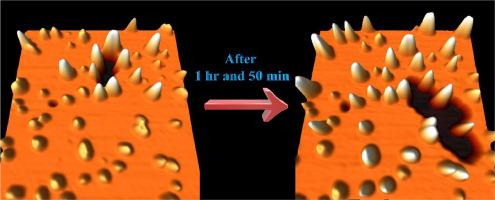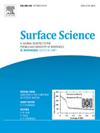室温下铂岛在 Ag(111) 上的生长和 Ag 封装
IF 2.1
4区 化学
Q3 CHEMISTRY, PHYSICAL
引用次数: 0
摘要
利用扫描隧道显微镜研究了室温下铂岛在 Ag(111) 亚单层覆盖层上的生长情况。提出了铂岛生长的两步机制。首先,铂通过位置交换过程取代了银基底原子。接着,铂原子在置换铂位点成核,铂岛随后从这些位点生长出来。在室温下,银原子迁移到铂岛表面,在台阶上形成空穴,在台阶边缘形成海湾。银原子在铂岛的角位点成核,铂岛上的银原子层从这些位点生长出来。本文章由计算机程序翻译,如有差异,请以英文原文为准。

Growth and Ag-encapsulation of Pt islands on Ag(111) at room temperature
The growth of Pt islands at submonolayer coverages on Ag(111) at room temperature were investigated with scanning tunneling microscopy. A two-step mechanism for growth of the islands is proposed. First, Pt replaces Ag substrate atoms through a place-exchange process. Next, Pt adatoms nucleate at substitutional Pt sites and Pt islands subsequently grow from these sites. At room temperature, Ag atoms migrate to cover Pt islands, creating vacancy pits on the terraces and bays on the step edges. Ag atoms nucleate at corner sites of the Pt islands, and the layer of Ag atoms on the Pt islands grow from these sites.
求助全文
通过发布文献求助,成功后即可免费获取论文全文。
去求助
来源期刊

Surface Science
化学-物理:凝聚态物理
CiteScore
3.30
自引率
5.30%
发文量
137
审稿时长
25 days
期刊介绍:
Surface Science is devoted to elucidating the fundamental aspects of chemistry and physics occurring at a wide range of surfaces and interfaces and to disseminating this knowledge fast. The journal welcomes a broad spectrum of topics, including but not limited to:
• model systems (e.g. in Ultra High Vacuum) under well-controlled reactive conditions
• nanoscale science and engineering, including manipulation of matter at the atomic/molecular scale and assembly phenomena
• reactivity of surfaces as related to various applied areas including heterogeneous catalysis, chemistry at electrified interfaces, and semiconductors functionalization
• phenomena at interfaces relevant to energy storage and conversion, and fuels production and utilization
• surface reactivity for environmental protection and pollution remediation
• interactions at surfaces of soft matter, including polymers and biomaterials.
Both experimental and theoretical work, including modeling, is within the scope of the journal. Work published in Surface Science reaches a wide readership, from chemistry and physics to biology and materials science and engineering, providing an excellent forum for cross-fertilization of ideas and broad dissemination of scientific discoveries.
 求助内容:
求助内容: 应助结果提醒方式:
应助结果提醒方式:


